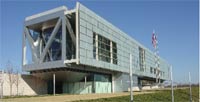
Fair Warning
Smoke detection emerges as a rapidly evolving security priority
- By Mariann McDonagh
- Feb 01, 2009
 Ask a group of physical security managers what their most critical security priority is, and not many would answer fire detection and prevention. However, according to the National Fire Protection Association, more than 3,000 lives and more than $10.6 billion dollars in damages were attributed to fires in the United States last year alone. A catastrophic fire can cause loss of life, damage to assets and inventory, and lost productivity due to downtime. In fact, according to KPMG, 40 percent of businesses that suffer a catastrophic disaster, such as a major fire, go out of business in less than two years.
Ask a group of physical security managers what their most critical security priority is, and not many would answer fire detection and prevention. However, according to the National Fire Protection Association, more than 3,000 lives and more than $10.6 billion dollars in damages were attributed to fires in the United States last year alone. A catastrophic fire can cause loss of life, damage to assets and inventory, and lost productivity due to downtime. In fact, according to KPMG, 40 percent of businesses that suffer a catastrophic disaster, such as a major fire, go out of business in less than two years.
Security managers, well aware of the dangers presented by fire, have established detailed evacuation and response procedures to protect lives in the event of a blaze. In addition, the security industry has experienced significant innovation in recent years in fire alarms, suppression systems and monitoring technologies, but they don’t do much to stop a fire before it progresses to the point where significant damage occurs to property and assets. This is due, in large part, to the time that lapses between the earliest stages of a fire and the point at which traditional fire detection and suppression systems are activated. Traditional smoke detection systems are typically activated when heavy concentrations of smoke reach sensors on the device, which most often occurs after a fire has reached full ignition and rapid progression.
Recently, an advanced and more proactive approach to fire security has been gaining popularity and adoption among security and fire and life safety managers: early warning smoke detection. EWSD refers to the application of policies and technologies to support a proactive approach to fire detection and prevention. This method is designed to help security and fire and life safety personnel identify a threat at the earliest stage of a fire’s progression. EWSD programs tightly integrate cutting-edge aspirating smoke detection technologies with physical security solutions to provide a holistic view of a fire event. EWSD can dramatically increase the preservation of life, as well as property and assets.
The Stages of Fire Progression
Before diving deeper into EWSD programs and technologies, we’ll first examine the four stages of fire progression. The first stage, the incipient stage, is when smoldering smoke is emitted before flames are present. The smoke level at this stage is typically very low and, in some cases, not visible to the human eye. In the second stage, the smoke becomes clearly visible and conventional detection techniques are initiated. Next, in stage three, flames are visible, accelerating the fire into the fourth stage, where heat detection initiates and fire suppression systems are often activated.
The principle behind EWSD is to activate an alarm in the first stage of a fire so it may be contained and extinguished before any significant damage occurs.
Conventional Solutions
There are several types of common smoke detection technologies often deployed in a facility—spot detectors, beam detectors and rate-of-heat-rise detectors. While these technologies are adequate in some scenarios, each has shortfalls that prevent it from being appropriate for an EWSD approach.
Spot detectors, also called point detectors, are one of the most common types of smoke detectors used. Spot detectors are passive; they wait for smoke to enter a detection chamber, where an optical sensor identifies the presence of smoke. A key problem with spot detectors is airborne debris, which can impede the flow of air and smoke into the detection chamber. This can lower sensitivity and minimize effectiveness. Unfortunately, not all spot detectors are equipped with automatic indicators to notify personnel when they have become contaminated. In addition, spot detectors are prone to nuisance or false alarms in some environments.
Beam detectors bounce a beam of light between two sensors to detect the presence of smoke. When a significant level of smoke disrupts the beam, an alarm is activated. Unfortunately, beam detectors are prone to nuisance alarms from obstructions or movement. These false alarms reduce users’ confidence in the effectiveness of beam detectors. In addition, beam detectors require regular cleaning and maintenance of reflectors and beam surfaces due to dirt and contaminants in the air.
As indicated by their name, rate-ofheat- rise detectors measure the rapid rise of ambient room temperature to identify the imminent threat of a fire. Rate-ofheat- rise detectors often are integrated with fire suppression systems and typically are mounted on ceilings, where heat from a fire collects. Unfortunately, a smoldering fire can produce very low heat levels, making these detectors ineffective for early detection.
|
William J. Clinton Presidential Center and Library
 Visitors to the William J. Clinton Presidential Library and Museum will see a number of interesting things, but one thing they won’t see is the VESDA® ASD solution from Xtralis, the pioneer in early-warning smoke detection systems. Visitors to the William J. Clinton Presidential Library and Museum will see a number of interesting things, but one thing they won’t see is the VESDA® ASD solution from Xtralis, the pioneer in early-warning smoke detection systems.
The $165-million William Jefferson Clinton Presidential Center and Library in Little Rock, Ark., opened its doors to the public in November 2004. Cantilevered over the Arkansas River to symbolize a “bridge to the 21st century,” Bill Clinton’s presidential library contains historical documents and memorabilia. Information about Clinton’s two terms in office includes a replica of the Oval Office and interactive exhibits. Visitors will not see the ASD system that protects the library’s most important archives. The highly sensitive but inconspicuous VESDA aspirated smoke detection system was chosen for the library’s three records rooms, which are accessible to researchers by permission only. The rooms’ vault-like walls are designed to hold off an outside fire for four hours.
The ASD solution is designed to detect an inside fire at stage one, before smoke is visible to human eyes. Display panels in the building’s security office and at two information desks give guards the earliest possible warning—early enough for them to find and control a potential fire source before smoke damages the contents of the library or flames set off the sprinkler system. The hundreds of gallons of water released by the sprinklers would extinguish a fire but could ruin the documents.
Two independent ASDs cover the rooms, which are divided into eight zones. The detectors actively and continuously monitor the air, looking for any presence of smoke. High-efficiency aspirators draw air from 68 sampling points to the detectors via a network of fire-resistant CPVC piping. The pipes are painted white to match the color of the concrete, waffle-style ceiling. While highly sensitive, the detectors have several built-in features to virtually eliminate nuisance alarms that plague other methods of detection. Auto-learning functionality built into the detectors prevents nuisance alarms by automatically adjusting the background levels to allow for changing ambient air conditions and external pollution. The detectors are serviced at an accessible level, eliminating the need to reach the ceiling and, thus, the need to erect scaffolding. |
Aspirating Smoke Detection Solutions
A new breed of aspirating smoke detection solutions are gaining rapid adoption among security and life safety managers. ASD solutions are designed to detect a fire while it is still in the first stage of progression, before smoke may be visible to the human eye. The most effective ASD solutions address reliability issues found in conventional smoke detectors through an alternative approach to capturing and analyzing air samples called aspiration. Aspirating smoke detection solutions use multiple air sampling tubes, spread out across large open facilities, to capture and filter air samples. These samples are quickly transported through a dual-stage filter to remove dust and other contaminants that can cause false alarms with conventional smoke detectors. Finally, air samples pass through a highly sensitive centralized laser detection unit. If smoke is detected, alarm signals are processed and transmitted to centralized monitoring stations, as well as to integrated systems such as building management, equipment control or fire suppression systems. The entire process takes only seconds. Because aspirating detectors are actively sampling the air in a facility, they are tolerant of smoke dilution and are reliable in high airflow environments.
ASD solutions provide security and life safety personnel with the earliest warning possible to allow for proper investigation and an appropriate and controlled response. In fact, when tested in a controlled environment, ASD solutions have proven consistently to outperform conventional detection solutions.
A series of fire tests for demonstration purposes was conducted by Xtralis, one of the leading providers of ASD solutions, at Victoria University’s Werribee Campus Warehouse Testing Environment. The purpose of these demonstration tests was to illustrate the smoke-detection capabilities of three detection technologies during the early developing stages of the fires and in a challenging environment—a warehouse— that promotes smoke dilution due to a high ceiling and natural ventilation.
The three technologies compared were an air-sampling ASD solution, a spot-type detector and a beam detector. Three small-scale fire/smoke tests were conducted using three fuels-smoke pellets, N-Heptane and timber logs. The ASD solution outperformed the spot and beam detectors. In many cases, the spot and beam detector failed to activate at all.
Further Considerations
There are several reasons to deploy ASD solutions as the foundation of an early warning smoke detection program.
When business continuity is paramount. ASD solutions are required when uptime and service provision are critical goals, for example, in telecommunications hubs or financial services data centers. ASD solutions provide the earliest warning of a potential fire, buying time to investigate and intervene, potentially avoiding damage, downtime and the cost of suppression release.
When smoke is difficult to detect. In high airflow environments, such as server rooms, indoor stadiums and open warehouses, smoke may never reach the ceiling, making it difficult to detect with conventional detectors. Smoke can become trapped in ducts, pockets or voids. ASD sampling points can be placed at the return air grill or in equipment cabinets, detecting the smoke as it is carried by the airflow. In a large open space, sampling points for ASD detectors can be placed where the smoke goes—often some distance below ceiling level.
When maintenance access is difficult. Ceiling voids, sub-floor spaces and elevator shafts are difficult to protect due to their inaccessibility. Maintenance on fire protection systems in these areas can cause disruptions and inconvenience. ASD solutions can be mounted in accessible locations, allowing easy access for maintenance. Only the sampling pipe network is placed in the inaccessible area.
When unobtrusive detection is required. In modern art galleries, museums and historic buildings, it’s important to preserve the internal design and atmosphere of the environment. ASD solutions are able to use tiny capillary sampling tubes, barely discernible to the human eye. The detectors can even be hidden in a cupboard or remote utility area.
When evacuation is a challenge. Many buildings are open to the general public, which may present a situation where elderly or handicapped people need assistance during an evacuation. In addition, in some facilities, such as hospitals, stadiums and underground tunnels, evacuation is difficult due to crowds and limited exits. ASD solutions allow the maximum time for a deliberate and orderly evacuation.
When environmental conditions are difficult. In mines, manufacturing facilities and outdoor public transit environments, poor air quality or extreme temperatures often prove too daunting for conventional smoke detection solutions. ASD solutions feature dual-stage filtration to ensure that they keep working in dirty environments. Detectors can be installed elsewhere, with only the sampling pipes in the extreme environment. The sampled air can be filtered, warmed or cooled before reaching the laser detection unit.
When suppression systems are present. Suppression release can be costly and disruptive. ASD solutions allow early intervention, before suppression is necessary. The multiple warning levels of an ASD solution can be used to trigger different responses at different stages of a fire, from controlling air conditioning to suppression release.
Historically, fire and life safety systems have been stove-piped or siloed from all other physical security systems within a facility. But the growth in intelligent, standards- based fire and life safety, physical security and building management systems offers significant potential benefits as these two critical functions become integrated. By integrating fire alarms with other physical security systems, fire and life safety personnel can benefit from the broader visibility provided by cameras, as well as a multitude of access control, environmental and security sensors.
However, for physical security and fire and life safety to join forces, security personnel will need to become more familiar with the systems used to prevent a fire-related disaster. ASD solutions and their early-warning approach are helping to break down silos and bridge the gap between this organizational division by providing a proactive and holistic view of a situation before it is able to escalate.
This article originally appeared in the issue of .